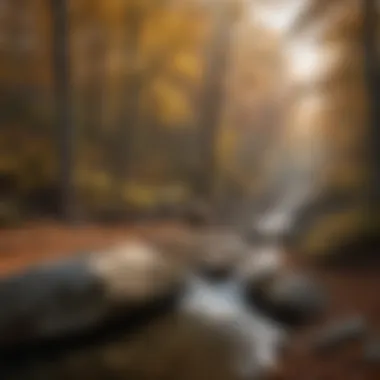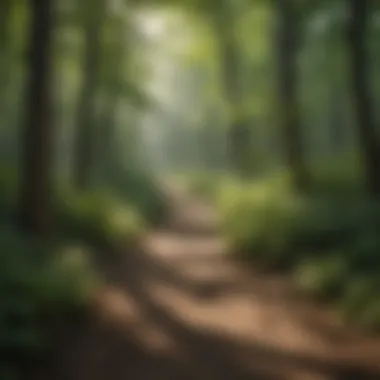Discover Shawnee National Forest: Your Ultimate Travel Guide


Understanding Woodland Ecosystems
The complexity of woodland ecosystems is vital for a comprehensive understanding of their significance within Shawnee National Forest. These ecosystems host an intricate web of life that contributes both to biodiversity and ecological stability. It is crucial to examine the importance of biodiversity and the role of forests in climate regulation.
Importance of Biodiversity in Forests
Biodiversity refers to the variety of life forms within a given ecosystem. In the context of Shawnee National Forest, this diversity includes a wide range of plant and animal species. Biodiversity enhances ecosystem resilience, ensuring that forests can recover from disturbances such as storms and diseases.
- Rich species variety contributes to the health of the environment.
- Diverse gene pools within plant and animal communities can adapt to climate fluctuations.
- Habitat variety supports different species’ needs, promoting overall ecological balance.
Such diversity is not merely a feature; it is a cornerstone of forest health. An environment with rich biodiversity can more effectively function, providing vital services such as pollination, pest control, and nutrient cycling. As such, it is imperative for visitors and professionals alike to appreciate the full tapestry of life present in Shawnee National Forest.
Role of Forests in Climate Regulation
Forests play a significant role in regulating the climate by sequestering carbon dioxide, producing oxygen, and regulating temperature. Shawnee National Forest stands as a vital carbon sink, absorbing carbon emissions from human activities.
- Trees absorb CO2, which helps mitigate climate change impacts.
- Forests influence local weather patterns, supporting a more stable climate.
- This area contributes to cooler temperatures, aiding biodiversity survival.
Recognizing the potential climate benefits provided by forest conservation can guide responsible tourism practices. Awareness of these factors enables travelers to engage more thoughtfully with the natural world, ensuring that their activities contribute positively to the ecosystem.
"In understanding the interconnection between biodiversity and climate stability, we equip ourselves to become better stewards of the land."
By delving into the intricacies of woodland ecosystems, one can appreciate the broader implications for conservation and responsible tourism practices within Shawnee National Forest. Whether you are a visitor, an educator, or a forestry professional, this understanding fosters a deeper respect for these vital ecosystems.
Intro to Shawnee National Forest
Shawnee National Forest holds a significant position in the context of both natural beauty and ecological importance. This vast expanse of land, located in Southern Illinois, offers a unique blend of recreational opportunities and diverse ecosystems. Visitors to this forest experience not just the rich landscapes but also an intricate web of history and conservation efforts that shape its existence today. Understanding these elements can enhance the experience for anyone seeking to explore this national treasure.
Geographical Overview
Shawnee National Forest covers approximately 280 square miles, nestled between the cities of Carbondale and Golconda. This forest exhibits a diverse range of geographical features, from limestone bluffs to open fields and dense woodlands. The terrain is marked by its unique topography, shaped by the confluence of the Ohio and Mississippi rivers nearby.
The highland areas, such as those found near the Garden of the Gods, offer breathtaking views and are accessible via a network of well-maintained trails. These trails lead visitors through several distinct ecosystems, showcasing a variety of plant and animal life. It is important to note that such diversity results in a rich ecological tapestry that supports countless species unique to the region.
Historical Context
The historical narrative of Shawnee National Forest is equally captivating. Established in the 1930s, this area was born out of an initiative to rehabilitate the land after significant deforestation in the previous decades. During this period, various programs aimed to restore the soil and promote sustainable forestry practices became imperative. This led to the creation of the Shawnee National Forest as a federal project, ensuring that the land remains protected for future generations.
Furthermore, the forest has deep indigenous roots. Native American tribes, such as the Shawnee and Potawatomi, originally inhabited this region. Their connection to the land reflects a profound understanding of sustainable living and environmental stewardship. Today, exploring Shawnee National Forest provides visitors with a chance to appreciate not only its natural beauty but also the cultural richness ingrained in its history.
Ecological Diversity
The ecological diversity of Shawnee National Forest plays a critical role in maintaining the complex interactions among its various species and habitats. This diversity is essential not only for the health of the forest itself but also for the overall ecological balance of the region. By understanding the components of this diversity, visitors and researchers alike can appreciate the intricate relationships present in this unique environment.
Shawnee National Forest houses a wide array of flora and fauna adapted to its varying topography, climates, and soil types. This rich biodiversity contributes to ecosystem resilience, allowing it to withstand environmental changes. Therefore, knowledge of ecological diversity can guide conservation efforts and promote sustainable practices within the forest.
Flora of Shawnee National Forest
Shawnee National Forest features an impressive range of plant species, with over 1,000 native plants identified within its boundaries. The dominant tree species include oak, hickory, and maple, which thrive in the mixed deciduous forests. Understory plants, such as dogwood and serviceberry, add layers to the forest and contribute to biodiversity. Additionally, the presence of rare plant species, including the Eastern Redbud and Virginia Bluebell, highlights the forest's ecological importance.
Seasonal changes in flora provide breathtaking views throughout the year. In spring, wildflowers bloom, creating vibrant carpets of color. Summer brings dense green canopies that offer shade and habitat for various animals. Fall transforms the forest with brilliant foliage. Understanding these plants helps visitors appreciate their role in the ecosystem, including their effects on soil stability, air quality, and wildlife habitat.
Fauna Found in the Forest


The fauna of Shawnee National Forest is equally diverse, with more than 200 species of birds, mammals, reptiles, and amphibians documented in the area. This rich fauna includes white-tailed deer, wild turkeys, and various owl species. Each species plays a fundamental part in its ecosystem, often serving as indicators of environmental health.
Birdwatchers flock to the area to spot migratory birds, while nature enthusiasts can observe wildlife in their natural habitats. The presence of predators, such as coyotes and foxes, helps maintain the balance of populations within the forest. An understanding of these species and their interactions is critical for conservation and effective management of the ecosystems within Shawnee.
Unique Ecosystems
Shawnee National Forest encompasses many unique ecosystems, from rolling hills to wetlands, each supporting distinct communities of plants and animals. One noteworthy ecosystem is the Shawnee Hills, characterized by its rugged terrain and steep slopes. This area supports a diversity of habitats, including forests, glades, and open fields. These variations create microenvironments that foster unique species assemblages, enhancing overall biodiversity.
Wetlands within the forest, such as marshes and swamps, also play a vital role in ecological health. They serve as filters for water, improve water quality, and provide habitat for amphibians and migratory birds. Protecting these unique ecosystems is essential for the sustainability of Shawnee National Forest, impacting not only local species but also the broader environment.
Overall, understanding the ecological diversity within Shawnee National Forest is crucial for promoting informed recreational activities and enhancing conservation strategies. By prioritizing biodiversity, visitors can contribute to the preservation of this remarkable natural landscape.
Recreational Opportunities
Recreational opportunities in Shawnee National Forest are diverse and tailored to meet the interests of various visitors. The forest provides a unique blend of activities that promote physical well-being and allow for immersion in nature. Engaging in these experiences helps foster a deeper appreciation for this ecological gem and contributes to mental clarity and relaxation. Understanding these opportunities effectively enhances one’s visiting experience.
Hiking Trails
Hiking in Shawnee National Forest is one of the foremost recreational activities. Trails wind through stunning rock formations, inviting woodlands, and wetlands. Popular trails include the Pomona Natural Bridge Trail, which showcases sandstone arches. The Giant City Nature Trail offers an easy path that provides access to scenic views and historical sites.
- Benefits of Hiking:
- Physical Fitness: Hiking promotes cardiovascular health and strengthens muscles.
- Mental Well-being: Nature has a calming effect that reduces stress and anxiety.
Careful planning is vital when choosing a trail. Some trails may vary in difficulty, needing consideration of your fitness level. Always carry enough water and wear suitable footwear.
Camping Facilities
Camping in Shawnee National Forest allows visitors to stay connected with nature overnight. There are several designated campgrounds, including Horseshoe Lake Campground and Hawk’s Nest Campground. These campsites are equipped with basic amenities like picnic tables, fire rings, and restroom facilities.
- Advantages of Camping:
- Immersive Experience: Being surrounded by nature deepens the connection to the environment.
- Social Interaction: Campsites offer opportunities to meet fellow outdoor enthusiasts.
Reservations are recommended during peak seasons to secure a site. Also, familiarize yourself with camp rules to ensure a respectful visit to nature.
Fishing and Water Activities
Shawnee National Forest encompasses various lakes and rivers, creating a haven for fishing and water activities. Lake Glendale is a recommended spot with easy access for families and solo anglers. The diverse aquatic ecosystem here supports species like bass and catfish.
- Benefits of Water Activities:
- Recreational Fishing: Promotes relaxation and patience, making it enjoyable for all ages.
- Kayaking and Canoeing: These activities provide perspectives of the forest that are otherwise inaccessible.
It is essential to follow state fishing regulations. A valid fishing license is necessary before casting your line.
Wildlife Observation
Wildlife observation in Shawnee National Forest provides a unique chance to connect with local fauna. Birdwatching is particularly popular, with species like hawks, woodpeckers, and an array of songbirds spotted throughout the year. Deer, wild turkeys, and even foxes may be viewed, especially at dawn and dusk.
- Importance of Wildlife Observation:
- Biodiversity Awareness: Understanding the variety of species emphasizes the importance of conservation.
- Educational Opportunities: Observing wildlife can enhance knowledge about ecosystem interactions.
To enhance your experience, invest in binoculars or a good camera. Ensure to maintain a safe distance from wildlife to avoid disturbing their natural behavior.


Engaging in recreational opportunities at Shawnee National Forest contributes to personal well-being while fostering ecological awareness.
Visiting the forest to enjoy these activities not only enriches individual lives but reinforces the community’s commitment to preserving this beautiful environment.
Planning Your Visit
Planning your visit to Shawnee National Forest is a crucial step for any traveler keen on maximizing their experience. Understanding the nuances of what to expect, along with the timing and preparedness, can significantly enhance your trip. This section aims to break down the essential elements that will assist you in organizing a successful visit, ensuring you engage fully with the unique aspects of this forest. Considerations like best visiting times, transportation options, lodging choices, and the gear you must have all contribute to a satisfying adventure in nature.
Best Times to Visit
The timing of your visit can greatly influence your experience in Shawnee National Forest. Each season brings with it distinct attributes.
- Spring (March to May): This period is characterized by blossoming wildflowers and cooler temperatures, ideal for hiking. The personalized beauty of nature during this time is hard to match.
- Summer (June to August): Summer months can get hot and humid, but it is also a vibrant time for outdoor activities like camping and swimming. Plan for sun protection as well as hydration.
- Autumn (September to November): This is often considered the best time to visit. The foliage becomes a striking array of colors, making it popular for photography and leisurely walks.
- Winter (December to February): While cold, this season affords solitude and a peaceful atmosphere. It's perfect for those who enjoy winter hiking, albeit with warm clothing.
Selecting the right timeframe aligns with both your preferences and the activities you wish to pursue.
Access and Transportation
Gaining access to Shawnee National Forest involves various transportation routes that are worth noting. The nearest major city is Carbondale, Illinois.
- By Car: The most convenient method to access the park is via car. Major roads lead directly to the forest.
- Public Transportation: Options are limited, but several buses operate from major cities, providing connections to local services such as taxis or rideshares.
- Biking: For the adventurous, cycling can be a method of entry, especially if you are staying in nearby areas.
Overall, plan your arrival route in advance and factor potential delays or detours that may arise due to weather or road conditions.
Lodging Options
Accommodation choices around Shawnee National Forest cater to varied preferences, whether for rustic camping or comfortable hotels.
- Camping: There are numerous campgrounds within the forest, such as Garden of the Gods and Little Grassy Lake. Reservations may be necessary, especially in peak seasons.
- Cabins and Lodges: For a more comfortable stay, places like the Shawnee Lodge offer essential amenities combined with natural beauty.
- Hotels: Nearby towns provide traditional hotel accommodations. Check options in Carbondale, Makanda, and other local areas for convenience.
Selecting lodging depending on your intended activities will aid in optimizing your experience in and around the forest.
Essential Gear and Supplies
Preparation is key to a rewarding experience in Shawnee National Forest. Necessary gear can vary based on the activities you intend to partake in.
- Hiking Gear: Sturdy boots, weather-appropriate clothing, and a reliable backpack are essentials.
- Camping Supplies: Be sure to carry tents, sleeping bags, and cooking gear if you plan on camping.
- Fishing and Water Gear: If you pursue fishing or other water activities, pack rods, reels, and safety equipment like life jackets.
- Safety Equipment: Always have a first aid kit, map, and compass or GPS device on hand to navigate the trails safely.
By assembling the right equipment, you ensure your journey is both enjoyable and safe.
Conservation Efforts
Conservation efforts play a pivotal role in maintaining the ecological integrity of Shawnee National Forest. Protecting this natural landscape is essential for preserving biodiversity, sustaining local ecosystems, and ensuring that future generations can enjoy its resources. As visitors traverse the lush trails or gaze at the diverse flora and fauna, they need to understand the underlying conservation initiatives that safeguard this precious environment. Without these measures, the unique habitats and species that thrive here could face significant threats from climate change, pollution, and human activities.
Role of the Forest Service
The United States Forest Service is at the forefront of the conservation initiatives in Shawnee National Forest. Their dedicated management strategies focus on balancing recreational use with ecological preservation. This includes monitoring wildlife populations, managing resources, and conducting research on forest health. The Forest Service also develops and enforces regulations designed to mitigate human impact, such as campfire restrictions or designated areas for camping. This proactive approach helps to maintain the delicate ecosystems while still allowing visitors to experience the beauty of nature. Furthermore, they organize educational programs to inform the public about the values of conservation.
Community Engagement in Conservation
Community involvement is vital in the conservation efforts at Shawnee National Forest. Local organizations and volunteers often come together to participate in clean-up days, tree planting events, and educational workshops. This engagement fosters a sense of stewardship among residents and visitors alike, emphasizing the importance of preserving natural resources. By working collaboratively, these groups can address specific environmental challenges and create a robust network that supports ongoing conservation efforts. Engaging local communities ensures that insights and knowledge from those who live or frequently visit the area inform conservation strategies.
Sustainable Forestry Practices
Sustainable forestry practices are integral to maintaining the health of Shawnee National Forest. These practices involve careful planning and management to ensure that woodlands produce timber and other resources without compromising ecosystem integrity. Techniques such as selective logging, reforestation, and integrated pest management help sustain both the forest's biodiversity and its economic value. Sustainable practices also consider the needs of local wildlife, protecting habitats while allowing for responsible harvesting. The adoption of these strategies supports not only the forest's ecological health but also the local economy, as sustainable forestry can lead to jobs and community development.


"Effective conservation relies on a combining of scientific knowledge, public engagement, and sustainable practices. Each element strengthens the ability to protect the forests we cherish."
Cultural Significance
The cultural significance of Shawnee National Forest encompasses a complex interplay of historical connections, indigenous practices, and contemporary cultural expressions. Understanding this significance allows travelers to appreciate not just the natural beauty of the forest but also the rich tapestry of human experiences that have unfolded within its boundaries. This knowledge deepens the visitor's connection to the landscape and promotes greater respect for its cultural heritage.
Indigenous History and Connection
Shawnee National Forest is located in an area historically inhabited by various Native American tribes, particularly the Shawnee peoples. Their connection to this land is profound, marked by spiritual beliefs and traditional practices that have been passed down through generations. The Shawnee people viewed nature as sacred, interwoven with their existence and culture. They relied on the land for sustenance, practiced hunting, fishing, and gathering, while also holding ceremonies that honored their relationship with the earth.
Archaeological findings, including ancient mounds and artifacts, illustrate the depth of this interaction. These discoveries provide insight into the life ways of the indigenous populations, highlighting their agricultural practices and social structures. Recognizing these elements fosters a greater understanding of the ecological wisdom inherent in indigenous practices and promotes the value of preserving cultural heritage within the forest's management.
Modern Cultural Practices
Today, the cultural landscape of Shawnee National Forest continues to evolve. Modern practices reflect a blend of indigenous influences and contemporary society's interaction with nature. Artists, crafters, and musicians often gather in this setting, using the environment as inspiration for their work. Events such as art festivals celebrate this melding of cultures, attracting both locals and visitors who participate in the experience.
Cultural organizations work to keep the history alive by offering educational programs that explore the traditions of the Shawnee and other tribes. These efforts promote cultural awareness and appreciation, inviting visitors to engage respectfully with the land and its stories. As people hike through the forest or participate in outdoor workshops, they not only enjoy the natural beauty but also contribute to preserving the cultural significance of Shawnee National Forest.
Understanding the cultural context of Shawnee National Forest enriches the visitor experience, enabling a deeper connection to the landscape and its history.
Overall, recognizing the cultural significance of Shawnee National Forest fosters a holistic approach to conservation and tourism. By valuing indigenous histories and modern cultural practices, one can appreciate the intricate relationships between nature and human experience in this remarkable forest.
Responsible Tourism
Responsible tourism plays a crucial role in preserving the natural beauty and ecological integrity of Shawnee National Forest. As more visitors explore this natural treasure, understanding the principles of responsible tourism becomes essential. This not only benefits the environment but also enhances the travel experience for those who come to appreciate the forest's unique features. Protecting resources and respecting wildlife are significant elements of responsible tourism. Visitors must realize their actions can have a lasting impact on the forest.
Leave No Trace Principles
The Leave No Trace principles provide guidelines that help mitigate human impact in natural spaces. These principles are designed to promote environmental stewardship among visitors. The seven core principles are:
- Plan ahead and prepare: Understanding the rules and regulations of Shawnee National Forest is key. It helps avoid last-minute surprises and ensures a well-planned visit.
- Travel and camp on durable surfaces: Stick to established trails and camp areas to prevent damage to sensitive habitats.
- Dispose of waste properly: Carry out all trash, leftover food, and personal waste to minimize pollution in the environment.
- Leave what you find: Preserve the beauty of the forest by not disturbing or removing natural or cultural features.
- Minimize campfire impact: Use a portable stove for cooking instead of making a fire unless it is permitted and safe to do so. Fires can scar the landscape and contribute to pollution.
- Respect wildlife: Observe animals from a distance and do not feed them. Feeding wildlife can disrupt their natural behaviors.
- Be considerate of other visitors: Maintain a low noise level and yield the trail to others, promoting a pleasant experience for all.
By adhering to these principles, visitors contribute to a sustainable future for Shawnee National Forest.
Impact of Human Activity
The human activity within Shawnee National Forest shows both positive and negative aspects. On one hand, tourism generates essential income for local economies and raises awareness about the importance of conservation. On the other hand, increased foot traffic can lead to soil erosion, disturbance of wildlife habitats, and littering.
The forest's resources are finite, and heavy impact can lead to long-term damage. Concrete paths and excessive clearing of land can alter the ecosystem dramatically. To mitigate these issues, scientists and conservationists emphasize the importance of balanced tourism. Here are some considerations:
- Monitoring Disturbances: Regular assessments of the forest's conditions ensure timely corrective measures can be enacted as needed.
- Education of Visitors: Informing visitors of local wildlife and ecosystems fosters respect and care for the environment.
- Sustainable Practices in Tourism: Encouraging eco-friendly businesses that minimize environmental impact.
Responsible actions now can lead to a flourishing Shawnee National Forest for generations to come.
Engaging with these concepts ensures that Shawnee National Forest remains a place of natural wonder for all to enjoy without compromising its integrity.
Closure
In this guide to Shawnee National Forest, the conclusion synthesizes the myriad experiences and insights related to this ecological gem. The forest is not just a collection of trees and wildlife; it embodies a rich tapestry of biodiversity, recreation, and cultural history. Understanding these facets is vital for both enjoyment and preservation.
Summation of Experiences
The experiences one can gather in Shawnee National Forest are diverse and enriching. From the visual splendor of the sandstone bluffs to the serene sounds of bubbling streams, the sensory engagement is profound. This area supports unique ecosystems, which contain rare and endangered species.
Visitors can indulge in various recreational activities. Hiking trails present a range of difficulty levels suitable for all competency. The flora dazzles between the wildflowers in spring to the vibrant foliage in autumn. Additionally, opportunities for wildlife observation provide insights into the forest's ecological balance. Engaging in these experiences helps foster a connection with nature. Understanding local ecosystems may inspire individuals to support conservation efforts beyond their visit.
Encouragement for Future Visits
Return visits to Shawnee National Forest are encouraged for various reasons. Each season presents a new aspect of the forest, allowing for different experiences and interpretations of the landscape. Spring features blooming wildflowers, while in summer, the dense canopy affords ample shade while hiking. Meanwhile, autumn showcases a tapestry of changing leaves and cool breezes that invigorate the spirit.
Furthermore, continuous updates to conservation efforts and recreational infrastructure enhance visitor engagement. Therefore, staying informed via resources like the Shawnee National Forest official website can solidify commitment to conservation and responsible tourism. In summary, Shawnee National Forest serves as a vital destination for collaborative ecological appreciation. Future visits can deepen understanding and appreciation of this national treasure, making it worthy of both exploration and protection.







